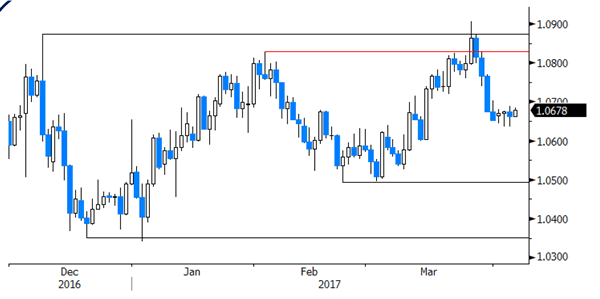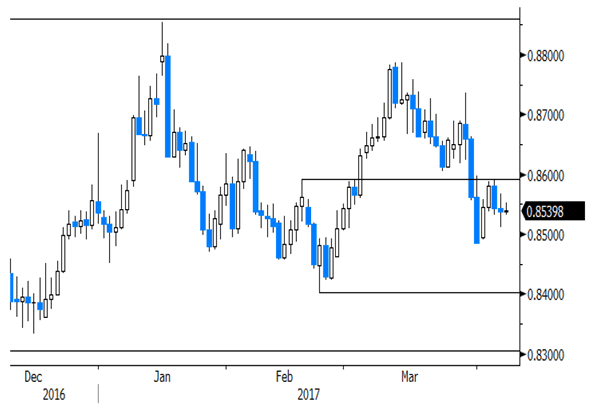Sunrise Market Commentary
- Rates: Risk off after US attack; focus on payrolls now
US Treasuries spiked higher overnight after the US conducted missile strikes against Syria, retaliating the gas attack earlier this week. The US 10-yr yield tested key 2.3% support, but a break didn’t occur. Today’s attention turns to the US payrolls report. With risks slightly on the upside of expectations, 2.3% should become even stronger support. - Currencies: Will payrolls be strong enough to restore a better USD bid?
The dollar stabilized yesterday after Wednesday’s post-Minutes correction. Overnight, USD/JPY revisited the recent lows on headlines of the US strike against Syria, but no break occurred. Later today, the focus for USD trading will be on the US payrolls. Of late, the dollar gradually lost interest rate support. Will the payrolls be strong enough to reverse this trend?
The Sunrise Headlines
- US equities ended a dull trading session with small gains. Risk sentiment deteriorated after the US conducted missile strikes against Syria. Most Asian equity indices lose around 0.3% with Japan and China outperforming.
- The US military launched nearly 60 Tomahawk cruise missiles against a Syrian air base this morning, responding to mounting calls for a display of force in the wake of this week’s suspected chemical-weapons attack in Syria.
- Under rules passed by the US Senate, lawmakers in the minority party will no longer be able to block presidential appointments to the Supreme Court a move so extreme it had been known as “the nuclear option”.
- Overtime pay in Japan, a barometer of strength in corporate activity, edged up in February for the first time in nine months, while real wages remained flat, government data showed on Friday
- The ECB has proposed that large branches of foreign banks in the EU be subject to tighter regulation and capital requirements, a move that would increase US and Asian lenders’ costs and also hit British banks after Brexit.
- ECB President Draghi yesterday looked to dull speculation that the ECB will halt its negative rate experiment later this year. In a press conference later in the day, ECB VP Constâncio said that Draghi has “a lot of support” for his stance
- Today’s eco calendar contains US payrolls and UK industrial production data. Euro-area finance ministers will try to break a months-long deadlock over Greece’s bailout in Malta. BoE Carney is scheduled to speak.
Currencies: Will Payrolls Be Strong Enough To Restore A Better USD Bid?
USD going nowhere ahead of the payrolls
The dollar regained slightly ground against the euro and the yen yesterday after Wednesday’s soft market reaction to the March Fed Minutes. EUR/USD dropped briefly on soft Draghi comments early in Europe, but the pair soon returned to wait-and-see modus ahead of today’s US payrolls. The pair closed the session at 1.0644 (from 1.0663). USD/JPY reversed early losses to finish the session at 110.81 (from 110.70).
Overnight, Asian markets were hit by a (temporary?) risk-off reaction as the US executed a missile strike against Syria in response to the use of chemical weapons. Markets followed the ‘standard risk-off procedure’. Equities and US bond yields declined. The yen rebounded. The oil price jumped also higher as markets feared more instability in the region. However, the reaction was limited and an important part of the moves is already reversed at the time of writing. Several Asian equity markets including Japan returned already in positive territory. USD/JPY dropped close to the recent low in the low 110 area, but the test was again rejected (currently 110.60). The moves in EUR/USD were very limited. The pair is holding a narrow range in the mid 1.06 area.
Today, there are plenty of second tier eco data. However, except for the fall-out from the Syria strike, focus of (FX) trading will be on the US payrolls. Payrolls started 2017 on a strong footing (238K and 235K in January and February). We expect an ongoing healthy labour market in March, but somewhat less buoyant. The market expects a 180K net job gains. Other labour market indicators gave some mixed signals of late. Still, we put the risk somewhat to the upside of expectations with the 6m and 12m average of 195K as our guesstimate. The unemployment rate might have stabilized at 4.7%, while we hope to see earnings to have stabilized at 2.8% Y/Y (consensus 2.7% Y/Y).
Of late, US bond yields drifted back to key support levels and this also weighed on the dollar. Our base scenario of in-line to slightly better than expected payrolls, should be good enough to prevent a sustained break lower of US yields and of the dollar. USD/JPY remains vulnerable to a downside test in case of a weak payrolls report. However, as we don’t expect a sustained decline of US yields beyond key support levels(10-j < 2.30%), a real USD sell-off is unlikely. EUR/USD didn’t show clear dynamics this week. We expect the topside to be rather well protected, even in case of a soft payrolls report.
Last week, the dollar decline slowed, but the subsequent rebound had no strong legs as US yields remain relatively low near key support levels. The Fed Minutes didn’t help the dollar even as the Fed confirmed its intention to continue policy normalization. The (FX) market apparently anticipates that reducing the balance sheet might slow the pace of Fed rate hikes. Both measures could go hand in hand if the US economy remains on track. In any case, further down the road, US monetary policy conditions will most likely be tightened which should be USD supportive.
From a technical point of view, USD/JPY last week failed to regain the 111.36/60 previous range bottom. A decline below 110 would signal more trouble ahead. We remain cautious on USD/JPY ST and first want a clear sign that a solid bottom is in place. EUR/USD extensively tested the topside of the MT range, but the test was rejected last week. The 1.0874/1.0906 area now looks a solid resistance. EUR/USD might return lower in the previous 1.0875/1.05 trading range

EUR/USD: perfectly calm going into the US payrolls release
EUR/GBP
Sterling stays in consolidation modus
Yesterday, sterling was driven by non-UK factors and technical considerations. EUR/GBP spiked briefly lower to the 0.8510/15 area on the Draghi headlines early in the European trading. As was the case for EUR/USD, the decline was almost immediately reversed. EUR/GBP hold a tight range in the mid 0.85 area further out (close at 0.8537 from 0.08542). Cable finished sideways at 1.2470.
Today, the UK calendar is well filled with The Halifax House prices, the production and the trade balance data. The production is expected to rebound after a poor reading in January. The trade deficit is expected more or less stable after a tentative better performance of the previous months. A further narrowing of the trade deficit might be slightly sterling supportive. BoE governor Carney will speak in London. If he says anything on the economy or on monetary policy we expect him to stress the uncertainty of the Brexit process and avoid any signal about policy tightening. Mid-March, sterling found a better bid after higher than expected UK inflation and a more hawkish tone from the BoE. We changed our short-term bias on EUR/GBP from positive to neutral. The EUR/GBP 0.88/0.84 range should guide trading for now. Since late last week, the sterling rally/shortsqueeze shows tentative signs of running into resistance, but we see no trigger for a real change in sentiment yet. Longer term, Brexit-complications remain a potential negative for sterling. We are not convinced that the BoE will raise rates anytime soon, even not after recent higher inflation data

EUR/GBP sterling short-squeeze is easing, but no sustained sterling correction yet












